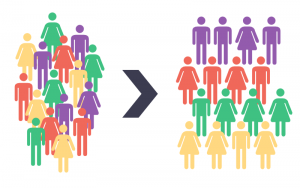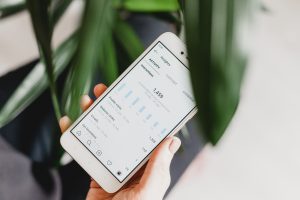Your customer base is extremely varied – their preferences, how they access your app and what they do in the app are all unique to each individual. Some linger on a single product, some browse everything and buy nothing and some buy the same thing over and over again. Since users have vastly different motivations and preferences for using an app, it is crucial that you are able have to group them based on those motivations.
Segmentation allows you to break up your audience into smaller groups based on a range of criteria from their attributes like age or gender to their behavior in app or interest in a product.

The ability to segment users based on them being black and white is currently unknown…
Why You Should Segment Users
Knowing which users are more likely to respond to your content is key to achieving your goals. Segmentation allows you to place your focus on different groups of users based on your app goals. The segmentation criteria should be as narrow as possible in order to better achieve your app goals. You can use this to create personalized campaigns that will be more likely to convert than generic campaigns sent to the whole audience.
Grouping your audience also allows your goals to be more focused. Rather than having a very high level goal of “increasing our overall sales by 10%”, you can set a goal of increasing sales in a particular segment. In some cases, the segment may shape the goal – if one audience demographic is made up of users who have low conversion rates, the next campaign goal can be focused on improving conversions in that demographic.

Simple segmentation can deliver huge benefits
Data
The key to effective segmentation is to ensure that you have great data about your users. A common mistake made when collecting user data is to get as much information as possible. This usually results in having a lot of data that isn’t required and identifying the relevant data you need can become like finding a needle in a haystack. You don’t need to collect big data, you need the right data. Collect only what is needed to achieve your goals.
Having a growth platform that can react to real time events within the app, is able to ingest information from multiple sources and sort users automatically is also key for successful segmentation, especially with a larger audience.
A fully featured growth platform is vital for keeping audience segments up to date and creating personalised campaigns with minimal input from the technical side of the app. We’ve covered previously how great push notifications utilise user data, resulting in increased conversions.

Using the right customer data results in more focused campaigns and higher conversions
Types of Segmentation
You can use basic customer data for segmentation, such as grouping users based on their demographic data. Utilizing gender, age and family status also allows for simple segments to be created and targeted. For example, your clothing brand doesn’t necessarily require in-depth data for specific targeting. If you are targeting middle-aged females with a young family, you don’t need specific app event information – it’s possible to obtain this information from app onboarding.
However, the addition of user data allows for multiple styles of segmentation to take place. Utilising in-app data allows customers to be categorised by their behavior – what products they’ve been looking at, what they’ve added or removed from their cart and what purchases they’ve made. To go back to our clothing brand, if there’s a product that people are interested in but never buy, you can segment the users who add it to their cart but don’t complete a transaction and then offer them a timed discount on the product to push the purchase over the line.
Location can also be utilized for segmentation. Users can be targeted with different offers based on where they currently are or where they will be in the future. Combining location data with other data points allows for hyper-targeted segmentation.

Keep the user journey in mind when making decisions relating to your campaigns
The Impact of Segmentation on Users
Segmenting users is the first step to changing user behaviour. This can be as simple as encouraging customers to use the app more frequently or encouraging them to make an app purchase.
Grouping users allows for more granular campaigns that directly address individual interests and are more likely to convert in relation to a very high level, generic campaign sent to all users. Users demand to receive personalized experiences that provide them with real utility.
In some cases, segmentation can be used to limit churn – grouping users based on usage activity, or lack thereof, and targeting those segments with targeted content can change their behaviour and result in them increasing their app usage.
Being able to effectively use segmentation is crucial for any business to be successful. As segments become increasingly granular, it allows conversion goals to become more specific. Utilising data to segment your audience can improve outcomes and ultimately create happier customers.
Pulsate is designed to help marketers analyze and gain useful insights from multiple data sources including CRM data, user behavior and precise location data. We’ve helped brands such as NCR, Planet Talk and Shell analyse and successfully segment their users and significantly improve conversions. Book a demo to see how Pulsate can help you grow in two weeks!







HAVE YOUR SAY. LEAVE A COMMENT